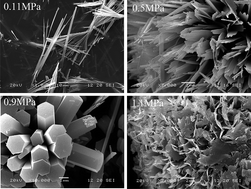Pressure effecting on morphology of hydroxyapatite crystals in homogeneous system
Abstract
Using Ca(NO3)2·4H2O, (NH4)2HPO4 and

* Corresponding authors
a
School of Material Science & Engineering, Wuhan Institute of Technology, Wuhan, China
E-mail:
cnsdqdccl@hotmail.com
Fax: +86-027-87195661
Tel: +86-027-63210785
Using Ca(NO3)2·4H2O, (NH4)2HPO4 and

 Please wait while we load your content...
Something went wrong. Try again?
Please wait while we load your content...
Something went wrong. Try again?
C. Chen, Z. Huang, W. Yuan, J. Li, X. Cheng and R. Chi, CrystEngComm, 2011, 13, 1632 DOI: 10.1039/C0CE00090F
To request permission to reproduce material from this article, please go to the Copyright Clearance Center request page.
If you are an author contributing to an RSC publication, you do not need to request permission provided correct acknowledgement is given.
If you are the author of this article, you do not need to request permission to reproduce figures and diagrams provided correct acknowledgement is given. If you want to reproduce the whole article in a third-party publication (excluding your thesis/dissertation for which permission is not required) please go to the Copyright Clearance Center request page.
Read more about how to correctly acknowledge RSC content.
 Fetching data from CrossRef.
Fetching data from CrossRef.
This may take some time to load.
Loading related content
